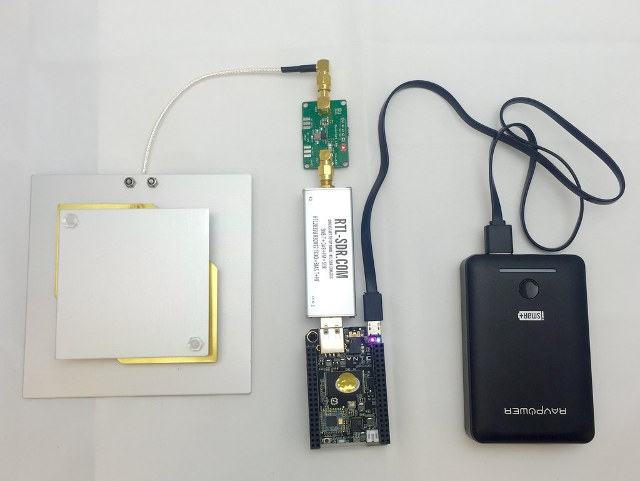Outernet goal is to bring knowledge and/or emergency info to places without Internet either to remote places, or where Internet has been temporary shutdown due to natural disasters or political reasons through a satellite feed. In some ways, it works like a typical FM radio, but instead of receiving audio, you’ll get data. The first hardware was based on WeTek Play TV box, and called Lighthouse, but they now have a DIY kit that will work with Next Thing C.H.I.P, Raspberry Pi, or Laptops running Windows 7/10 or Linux, as well as a standalone Outernet Satellite kit including C.H.I.P Allwinner R8 development board.

Let’s first check out “Basic Outernet DIY Kit” comprised of three items:
- L-Band Antenna
- Frequency: 1525 – 1559 MHz (Center frequency: 1542 MHz)
- 8dbi
- 4″ SMA Male connector
- Dimensions – 12 cm x 12 cm x 1.5 cm
- Weight – ~100 grams
- RTL-SDR Blog Software Defined Radio/Tuner USB dongle
- Ultra-low phase noise 0.5PPM TCXO
- RF-suitable voltage regulator and custom heatsink
- SMA female connector
- SDR frequency range of approximately 25MHz – 1700MHz
- Bias tee (software enabled)
- Outernet/Inmarsat Amplifier (LNA) board
- Frequency: 1525 – 1559 MHz (Center Frequency: 1542 MHz)
- Gain – 34 dB
- Voltage – 3.0V – 5.5V
- Current Draw – 25 mA
- Dimensions – 6.5 cm x 1.5 cm x 2.5 cm
- Weight – 8.5 grams
The kit costs $69, but it’s not usable standalone, and you’ll need to connect the USB dongle your own C.H.I.P or Raspberry Pi 3 board running rxOS operating system, or laptop and configure them as explained in the documentation to configure and run the system in order to access Outernet Library through your satellite (DVB-S). It should be possible to use other boards too, but you’d have to handle the software part yourself. It should not be too complicated since the only hardware interface is a USB port.
However, if you want something that mostly works out of the box, you should consider “Deluxe Outnert DIY receiver kit” with included all items from the basic kit, plus a pre-configured C.H.I.P board, and a battery pack for $99.

Once you’ve assembled the kit, pointed the L-band antenna to the right satellite, and completed the configuration through the web browser of a WiFi enabled device such as a smartphone. Outernet kit will freely download data (textbooks, health guides, courseware, weekly news, emergency info, disaster alerts, crop prices…) depending on your selected satellite, and anybody with a smartphone or computer will be able to access the data updated weekly/daily.
You’ll find the some details explaining how Outernet works and available data on my first post about Outernet, or for the complete details, visit directly Outernet.is.

Jean-Luc started CNX Software in 2010 as a part-time endeavor, before quitting his job as a software engineering manager, and starting to write daily news, and reviews full time later in 2011.
Support CNX Software! Donate via cryptocurrencies, become a Patron on Patreon, or purchase goods on Amazon or Aliexpress




